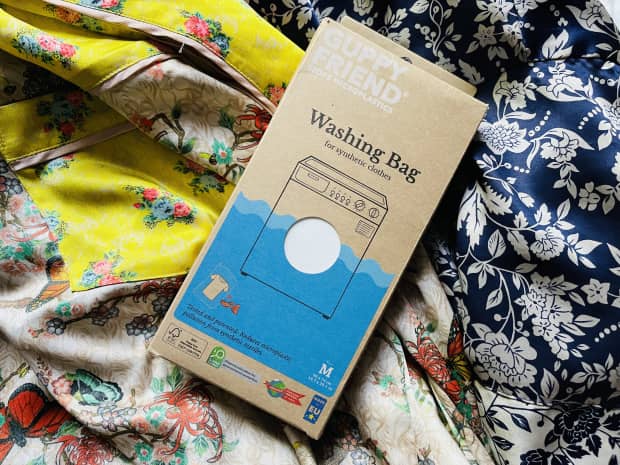
What Are Microplastics and Why Are They Harmful to Humans?
Plastic pollution in the ocean can lead to microplastics and nanoplastics entering our foodstreams and water sources. Here’s what you need to know.
Read More


Last Updated: September 24, 2022
Got microplastics? Guppyfriend is an innovative solution to microplastic pollution. We tried it out to see what all the hype is about.
By Mackenzie Sanford
Our clothes are made of plastic. Of course, not all of our clothes are so closely related to a lego brick, but a fair amount — like the yoga pants I can’t stop wearing and that acrylic sweater I found at the thrift store.
Plastic clothes might not seem like a big deal, but consider this: plastic clothes shed microplastics when they’re washed, and those microplastics can end up in our seas. In fact, microplastics make up around 35% of all plastic in the ocean. Suddenly, those colorful polyester button-ups in my closet seem a lot less snazzy and a lot more sinister. But all hope is not lost.
Guppyfriend is a new way to stop microplastics from shedding while you wash your synthetic clothes. I tried it out to see how it works, how it’s made, and how much it can fit (spoiler alert: it can almost fit a Golden Retriever).
Everywhere! Well, not everywhere, but there’s a lot of plastic in the world and, subsequently, a lot of opportunities for microplastics to rear their tiny, ugly heads. Microplastics come from cosmetic glitter (look for biodegradable glitter instead, friends!) and microbeads in face scrubs (here are a few face scrubs made from natural exfoliants). Plus, they can shed off of larger plastic items such as plastic bottles, tires, and Tupperware.
But that’s not what we’re here to talk about. A major contributor to the microplastic problem is synthetic fiber — think exercise clothes and that 70s polyester dress in your closet. When you wash manmade fabrics, they shed microplastics that end up in wastewater — which is used to irrigate crops. As a result, microplastics have been found in apples, salt, and sugar. Not so sweet, right?

Guppyfriend is an innovative solution to microplastic pollution. It’s a mesh laundry bag that traps the microplastics your clothes shed, reduces the amount of shedding, and prevents the lil’ plastics that do shed from washing down the drain.
And look at the size of this thing! Ace, my handsome model, is a fully grown Golden Retriever, and he could probably fit inside the bag. Think of the countless pairs of workout pants it’ll hold! It’s huge — and this is just the medium size. Guppyfriend also comes in a large size for folks who really love athleisure and a small size (which probably would’ve been a better choice for me, but I’ve always enjoyed being a bit extra).

Guppyfriend is made from polyamide 6.6, a fabric composed of undyed, untreated monofilaments that contain zero additives. Monofilaments themselves are a type of synthetic fiber — which sounds counterintuitive for a bag meant to prevent synthetic fabrics from shedding microplastics. But Guppyfriend is special.
It doesn’t shed because the fibers are made from sturdy sticks rather than flexible threads, which stops them from breaking off. And microplastics from your clothes won’t slip through Guppyfriend’s mesh because the bag’s design prevents microplastics from poking out vertically.

Put your laundry in the bag. Easy! It’s best not to fill the bag to bursting — too full, and your clothes won’t be able to move around inside the bag and get properly clean. That said, you’d have to have a lot of dirty synthetics to fill this entire bag.

Toss the bag into your washing machine with your non-synthetic clothes. Guppyfriend recommends washing synthetic fibers in cold water because it helps reduce the amount of shedding — plus, it’s better for the environment. A win-win!
Tumble drying synthetic fibers, even in the Guppyfriend bag, can lead to shedded fibers that escape into the dryer. Hang your clothes outside to dry if the weather allows it, but you can also hang them inside if you’ve got the room.
I was expecting to find a nice little lump of moist microplastic fibers tucked into the corners of the bag — but alas, my clothes didn’t shed enough microplastics for there to be a photographable outcome. Guppyfriend says this is because a) many microplastic fibers are transparent and hard to see, and b) the bag itself helps prevent fibers from shedding in the first place. I’ll take it!
Another thing I really like about Guppyfriend is that you can use it for more than just Lycra sports bras and vintage polyester — it’s also great for washing delicate items like hand-knit sweaters and fancy lingerie. Oh la la.
Overall, I’d rate it a 10 out of 10. While I’m disappointed I didn’t get to scoop a sopping wad of wet microplastics out of the corners, I have no doubt that it’ll catch microplastic fibers when they do decide to shed. I love how easy the bag is to use, and I feel less guilty about my faux silk kimono addiction knowing I can wash them without adding to the microplastic pollution crisis.

About the author: Mackenzie Sanford is a writer and musician eating microplastics in the Midwest.

Plastic pollution in the ocean can lead to microplastics and nanoplastics entering our foodstreams and water sources. Here’s what you need to know.

Here's the 28 best plastic-free storage solutions determined by Grove members. Select from any on the list and get them delivered to your door!

We've pulled the 8 best plastic-free and eco-friendly laundry detergents as top-rated by Grove members. Select from any on the list and get them delivered to your door!

We've got a list of the 14 best products in aluminum packaging, as chosen by Grove members.